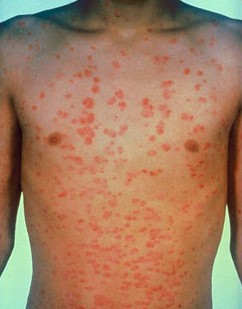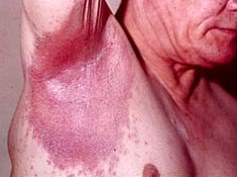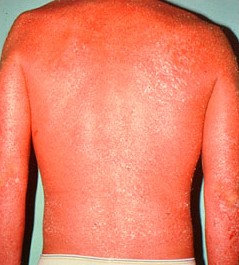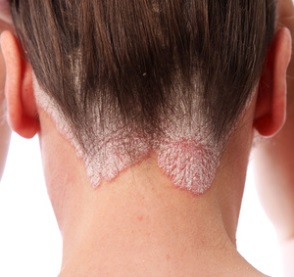What does psoriasis look like? Well, there are several different types of psoriasis and different types of the condition manifest in different ways, which can sometimes make it difficult to determine if what you’re experiencing is in fact psoriasis. We’re going to show you some psoriasis photos so you can see how different types of psoriasis appear in different parts of the body.
Plaque Psoriasis

Plaque psoriasis is the most common form of psoriasis. Plaques are large red areas on the skin, covered with whitish or silvery scales. The skin is thick and tough. In this photo, you can see plaque psoriasis on different areas of the body, including chest and elbows.

Guttate Psoriasis
Guttate psoriasis differs in appearance from plaque psoriasis. See how there are small red spots instead of large plaques? Often there are more than one hundred spots.
Pustular Psoriasis
Pustular psoriasis may look similar to plaque psoriasis or guttate psoriasis, but there are also small blisters containing white pus that appear on the skin. Despite the way it looks, pustular psoriasis is not contagious and the pus in the blisters is not infectious.
Inverse Psoriasis

Inverse psoriasis, also known as intertriginous psoriasis, usually appears inside or under folds of skin, like under the breasts, in the armpits, or in the groin area. It’s most common in obese people. It causes smooth, shiny red areas without any scales and without the thick, tough skin seen with plaque psoriasis. Because the areas in which inverse psoriasis is seen are generally moist, scales don’t develop.
Erythrodermic Psoriasis

As you can see from this photo, with erythrodermic psoriasis, the skin is extremely red and looks almost as if it has been burned. It’s usually very painful and people often experience a very rapid heartbeat and a high fever or an abnormally low body temperature, as well. The National Psoriasis Foundation explains that unlike other types of psoriasis, erythrodermic psoriasis is very dangerous and may even be life-threatening because heart failure may occur, so if you think you might have the condition shown in these erythrodermic psoriasis photos, contact your doctor right away or go to the nearest emergency room.
What Does Psoriasis Look Like on The Scalp?

Psoriasis can occur in many different parts of the body. One place it’s often seen is on the scalp. Here you can see how that might look. Of course, if you have a full head of hair, it may be somewhat difficult to see the condition of your scalp. Psoriasis can cause severe itching, though, and excessive scratching can lead to hair loss, so you may begin to notice thinning hair over time if you don’t get treatment for psoriasis of the scalp.
What Does Psoriasis Look Like on The Hands And Feet?
Psoriasis may look different on the hands and feet than on the arms, legs, and torso. Pustular psoriasis is common on the hands and feet, but other types of psoriasis may appear there, as well.
 |  |
How do You Treat Psoriasis?
Now that you know what does psoriasis look like, you’re probably wondering how to treat it if you have a condition that looks like those pictured here. First, if you’re not certain you have psoriasis, we recommend seeing your doctor for a diagnosis. Treatments that help psoriasis may not help other skin conditions.
If you do have psoriasis, we suggest you consider Terrasil Psoriasis Therapy Max. It’s useful in treating all types of psoriasis. It contains salicylic acid, which is related to aspirin and helps reduce the redness, swelling, and inflammation that accompany all types of psoriasis. Other ingredients, such as peppermint oil and volcanic clay, help relieve the itching and discomfort that comes with the condition. To learn more about our favorite treatment for psoriasis, just follow the link.
National Psoriasis Foundation: Erythrodermic Psoriasis
